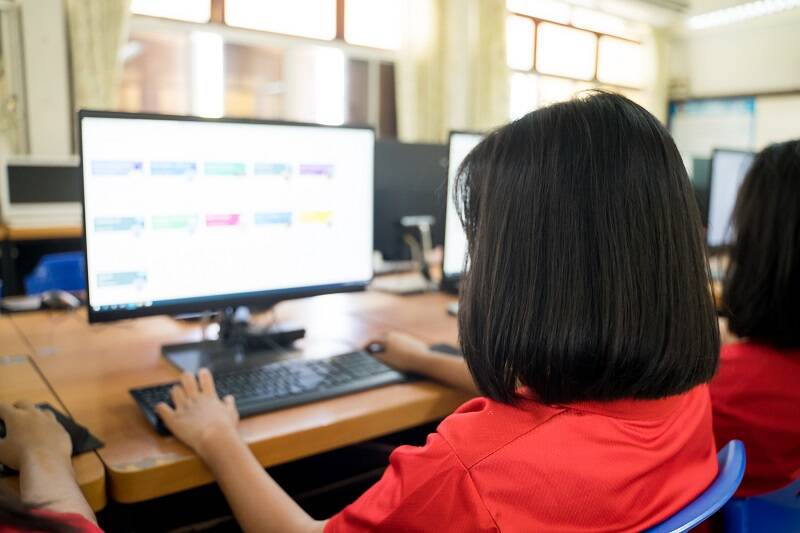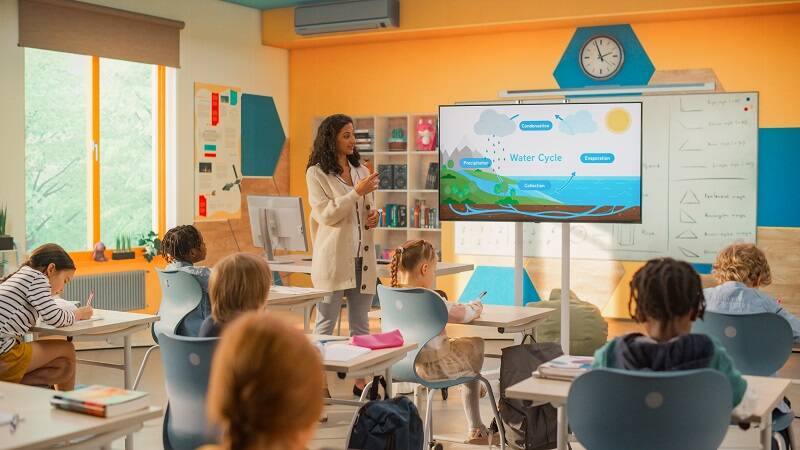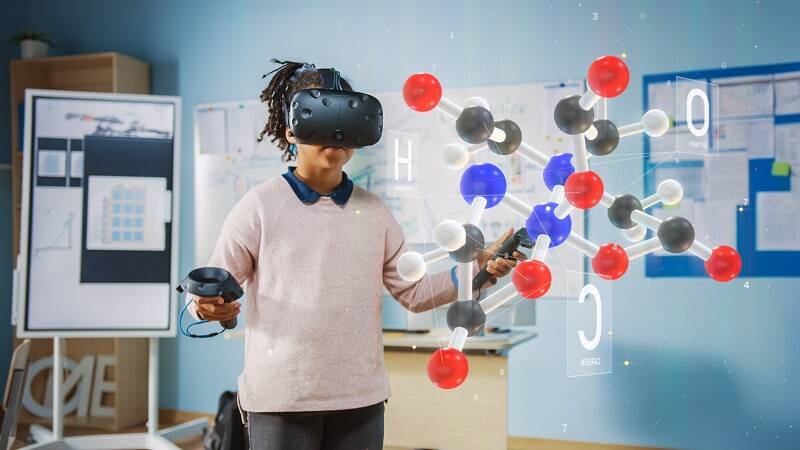Technology in Education: Computers, Displays, AR/VR, AI
It’s back-to-school time in the US, China, Europe, and many other countries in the Northern Hemisphere, so we take a look at the use of technology in education—how it’s being used, the latest trends, and predictions for the future.
Computers, Tablets, & Laptops
In 2019, 82% of US schools reported having computers for each student, or for each student in some grades or classrooms.1 Since then, the COVID-19 pandemic brought a sudden transition to remote video classes and an explosion of online learning portals at all levels, from elementary ages through high school, college, and beyond. In recognition of this new, connected learning environment, schools have taken up the charge. Seventy-four percent of school districts across the US now have school internet connectivity "at speeds that are sufficient to support digital learning in their classrooms every day—impacting 27.1 million student."2 A reported 89% of K-12 teachers now use technology in the classroom,3 and some school districts have implemented programs to help low-income families obtain internet connectivity at home.
Computing devices and internet connectivity can bring many learning benefits. They can even the playing field by giving all students access to the same online textbooks and resources that small and disadvantaged schools wouldn't have been able to afford in print. Digital devices provide opportunities for connectivity and engagement for students accross the room or accross the country. And teacher's roles are shifting from being the source of all information to being a guide as students take more intiative in their learning. Another benefit is differentiation, letting students at different learning levels (such as different reading levels) access content that's suited to their scholastic progress.

Displays
Back in my elementary school days (in the Stone Age), I remember the teacher pulling down a big white screen and rolling in a cart with the school's one and only projector so we could watch an educational filmstrip or movie. It was a rare and exciting event. Now, many classrooms have smart televisions, making it easy to integrate dynamic video and multi-media content into the everyday learning experience. For younger grades, TVs can help with developing listening skills and language acquisition. Presenting information in a "fun" context, for example using animation, makes it easier for kids to remember.

For middle and high-schoolers, video and film content on history, science, geography, and current events can provide a broader learning experience and spur class discussions. A new category of "virtual field trips" has sprung up, with organizations such as Stanford University Accelerator for Learning and Discovery Education offering a range of videos and interactivity that can take students all over the world and introduce them to other cultures and experiences.
AR/VR
The immersive nature of virtual reality makes it a powerful experiential learning tool, letting the headset wearer feel like they are in a different place or time. And the interactivity possible with AR and VR offers new possibilities for learning, for example, a student can rotate an image of the Earth 360 degrees to explore its landscape, zooming in to access in-depth information on different countries or geological features. But "the educational possibilities now go beyond putting on a headset and experiencing life in a distant location. With new technologies, students can create their own local interactive 360-degree scenarios, using just a cell phone or inexpensive camera and simple online tools."4 AR/VR devices can also foster collaboration between learners, which has been shown to increase academic motivation compared to students engaged in solo learning.5

Looking Ahead: AI
Adoption of these technologies in the classroom is likely to increase. Experts predict that the use of immersive devices (AR/VR/MR) will grow rapidly. Another trend will be more "gamification" of learning, with dynamic interactive applications and videos where the "reward" of winning the game helps motivate the learning process.
With the recent developments in AI, many teachers and parents are concerned that students are using tools like ChatGPT to cheat on writing assignments and homework. But AI detection tools are helping stem the tide, and educators are finding other ways to make good use of the technology. For example, some teachers are using AI to generate reading assignments or coach students on writing. "AI can also help automate tasks like grading and lesson planning, freeing teachers to do the human work that drew them into the profession in the first place,"6 according to Victor Lee, associate professor at the Stanford Graduate School of Education.
Quality Considerations
At Radiant, we aren’t educators or curriculum experts, but we do know a lot about consumer display devices such as laptops, TV screens, and AR/VR headsets. For more than 30 years our systems have been used to measure the visual quality of display screens of all shapes and sizes—from smart glasses and cell phones to stadium jumbotrons, and everything in between. As the educational market continues to embrace new technologies, we’ll be right there helping manufacturers ensure that their products provide the high-quality visual experience to support student learning.
CITATIONS
1. "Forty-five percent of schools reported having a computer for each student...An extra 37 percent reported having a computer for each student in some grades or classrooms." Use of Educational Technology for Instruction in Public Schools: 2019—20, published by the National Center for Education Statistics at IES (Institute of Educational Sciences), U.S. Department of Education, NCES-2021-017.
2. Ascione, Laura, "Majority of districts now meet FCC’s school internet connectivity goal," eSchool News, January 3, 2024.
3. Lockwood, Jessica, "Technology in Education: Promoting Student Engagement," University of Connecticut Center for Career Readiness and Life Skills, December 14, 2023.
4. Spector, Carrie, "How technology is reinventing education," Stanford Report, February 14, 2024.
5. How 5 Trending Technologies Are Defining the Future of Higher Education, eBook from Open LMS.
4. As quoted in Spector, Carrie, "How technology is reinventing education," Stanford Report, February 14, 2024.
Join Mailing List
Stay up to date on our latest products, blog content, and events.
Join our Mailing List
